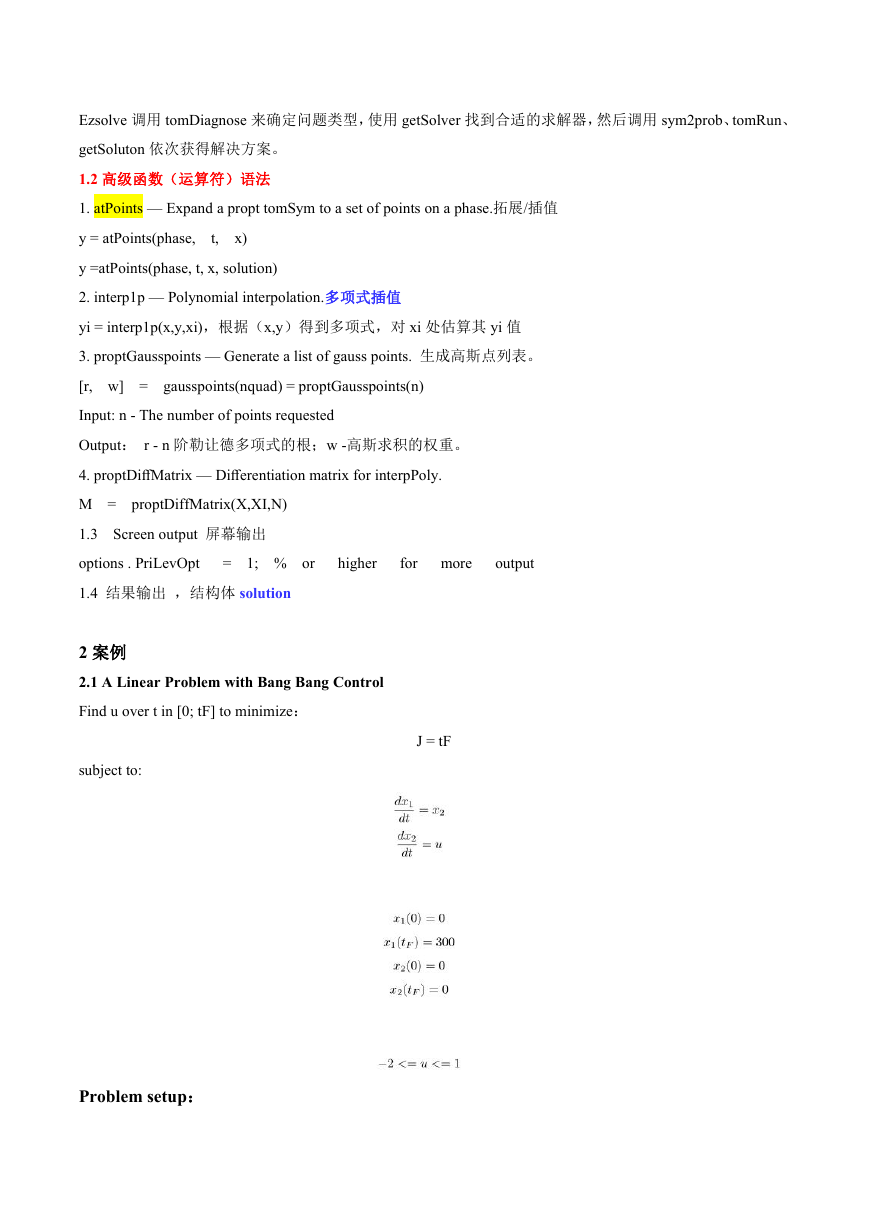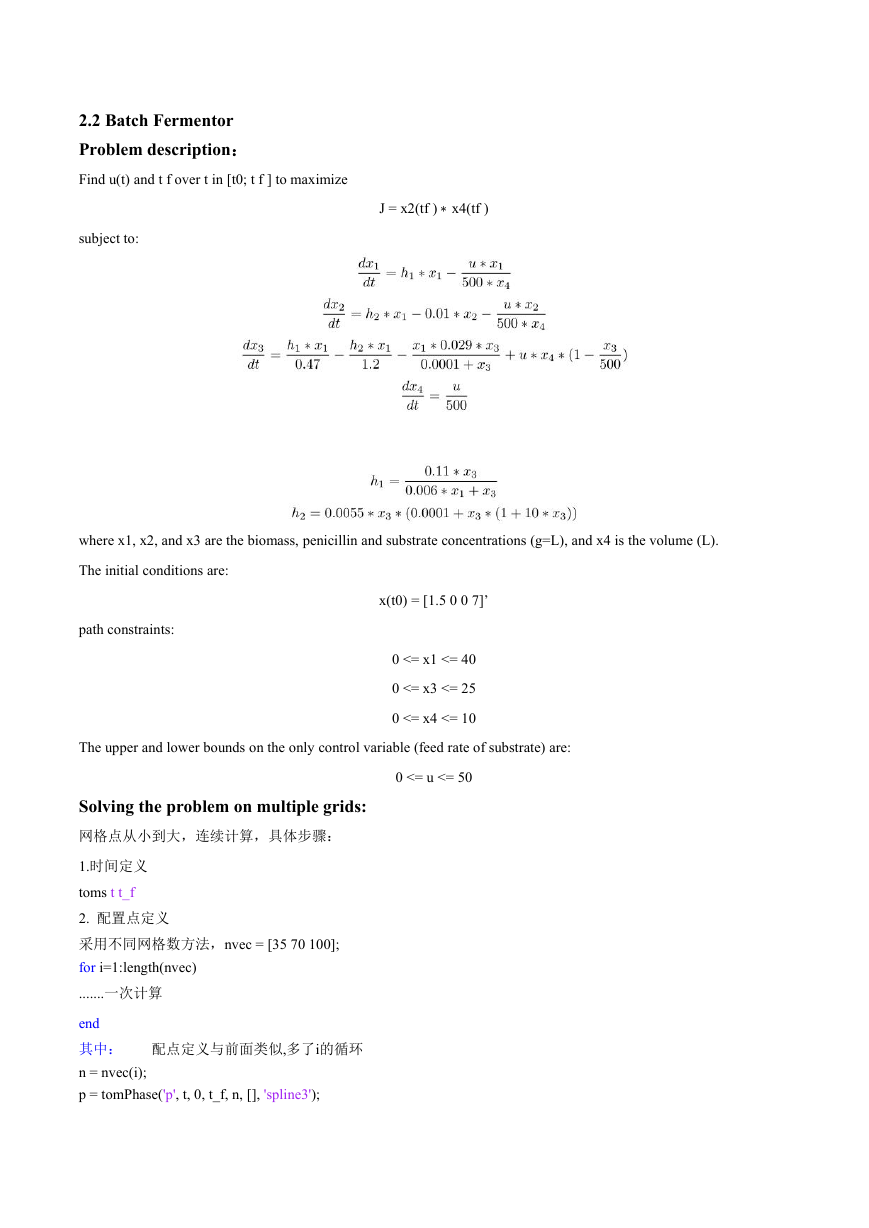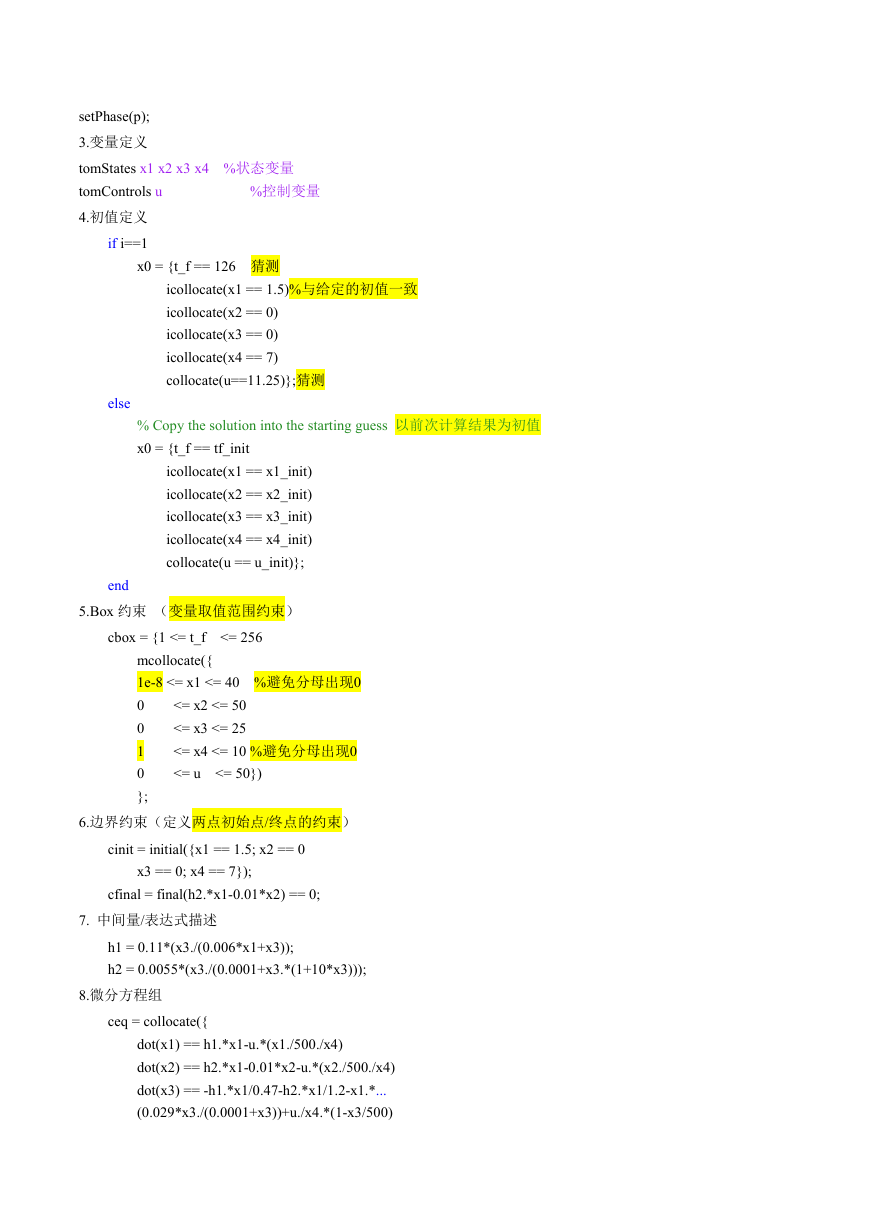TOMLAB/PROPT 学习笔记
(---最优控制问题的求解方法 2)
1. PROPT 语法
简介:
包含状态方程、初始或终端条件、代价函数,其他方程和变量
1.1 标准函数、运算符语法:
1. collocate — Expand a propt tomSym to all collocation points on a phase.扩展到全部配置点上
格式:y = collocate(phase, x)
2. dot 微分
格式:dot(p,x)
如果已经调用 setPhase(p),可简化为 dot(x)。适用于其他?y = collocate(phase, x)?
3. final — Evaluate a propt tomSym at the final point of a phase.估算最后点的值
y = final(phase,
4. icollocate — Expand a propt tomSym to all interpolation points on a phase 扩展到全部插值点上
与 collocate 类似,除了插值点是用来代替搭配点。 这在构造初始猜测时通常很有用。
5. initial — Evaluate a propt tomSym at the initial point of a phase.计算初值
y = initial(phase,
6. integrate — Evaluate the integral of an expression in a phase. 计算积分值
y = integrate(phase,
7. mcollocate — Expand to all collocation points, endpoints and midpoints on a phase. 扩展到全部配置点、终点、
x)
x)
x)
中间点上,用于设置涉及状态变量的不等式。应注意确保不与任何初始或最终条件冲突。
x)
y = mcollocate(phase,
8. setPhase — Set the active phase when modeling PROPT problem.设置 phase 阶段
格式:setPhase(p)
可以省略 tomState,tomControl,initial,final,integrate 等命令的阶段参数。
9. tomControl — Generate a PROPT symbolic state. 定义控制变量
�
scalar PROPT control with
a
x = tomControl ,creates
x = tomControl(phase,label) , creates
a
x = tomControl(phase,label,m,n) ,creates
x = tomControl(phase,[],m,n) , creates
x = tomControl(phase,label,m,n,’int’) , creates
x = tomControl(phase,label,m,n,’symmetric’), creates
10.
tomControls
a matrix
an
x
y
z
an
scalar
control with
a m-by-n matrix
automatic
the
of
control with
integer matrix
controls.
an
symbol.
symmetric matrix
a
tomControls — Create tomControl objects 定义控制变量
name.
provided
name.
name.
automatic
symbol.
等效于:
x = tomControl(’x’);
y = tomControl(’y’);
z = tomControl(’z’);
11. tomPhase — Create a phase struct 产生配置点
n)
phase = tomPhase(label,
phase = tomPhase(label,
ipoints,
如:p = tomPhase('p', t, 0, tf, 30);0-tf时间内,划分30个点
If n > 128 then Chebyshev points are used instead.)
phase = tomPhase(label, t, tstart, tdelta, n, [], 'cheb')
tdelta,
tdelta,
tstart,
tstart,
t,
t,
cpoints)
an
name.
creates
automatic
a
creates
scalar PROPT state with
creates
12. tomState — Generate a PROPT symbolic state ,定义状态变量
x = tomState
a
x = tomState(phase,label)
x = tomState(phase,label,m,n)
a matrix
x = tomState(phase,[],m,n)
creates
creates
an
x = tomState(phase,label,m,n,’int’)
x = tomState(phase,label,m,n,’symmetric’)
symbol.
creates
13 tomStates — Create tomState objects as toms create tomSym objects ,定义状态变量
如:tomStates
the
scalar
state with
state.
a m-by-n matrix
state with
an
integer matrix
automatic
symbol.
symmetric matrix
provided
name.
name.
x
y
z
a
补充:
14. toms 定义时间变量
toms t t_f
15. ezsolve 求解
Solution = ezsolve (objective, constraints)
[solution, result] = ezsolve(objective, {cbox, cbnd, ceq}, x0, options);
�
t,
x)
Ezsolve 调用 tomDiagnose 来确定问题类型,使用 getSolver 找到合适的求解器,然后调用 sym2prob、tomRun、
getSoluton 依次获得解决方案。
1.2 高级函数(运算符)语法
1. atPoints — Expand a propt tomSym to a set of points on a phase.拓展/插值
y = atPoints(phase,
y =atPoints(phase, t, x, solution)
2. interp1p — Polynomial interpolation.多项式插值
yi = interp1p(x,y,xi),根据(x,y)得到多项式,对 xi 处估算其 yi 值
3. proptGausspoints — Generate a list of gauss points. 生成高斯点列表。
[r, w] = gausspoints(nquad) = proptGausspoints(n)
Input: n - The number of points requested
Output: r - n 阶勒让德多项式的根;w -高斯求积的权重。
4. proptDiffMatrix — Differentiation matrix for interpPoly.
M = proptDiffMatrix(X,XI,N)
1.3 Screen output 屏幕输出
options . PriLevOpt
1.4 结果输出 ,结构体 solution
= 1; % or
for more
higher
output
2 案例
2.1 A Linear Problem with Bang Bang Control
Find u over t in [0; tF] to minimize:
J = tF
subject to:
Problem setup:
�
Solve the problem:
编程方法总结,步骤:
1.时间变量定义,toms t t_f ,由于t_f自由,须定义它
2.配置点定义,
p = tomPhase('p', t, 0, t_f, 30);固定格式
setPhase(p);
3.控制变量和状态变量定义,
tomStates x1 x2
�
tomControls u
4.初值定义
x0 = {
t_f == 20
icollocate({x1 == 300*t/t_f; x2 == 0}) %在插值点上。 x1怎么不是0?
collocate(u==1-2*t/t_f) %在配置点上对u设定初值
};
5. Box(?)取值范围约束
cbox = {
10 <= t_f <= 40
mcollocate(-2 <= u <= 1) %u适用于全部点
};
%tf范围?
6.边界约束
cbnd = {
initial({x1 == 0; x2 == 0}) %初值
final({x1 == 300; x2 == 0}) %终值
};
7.ODE 方程组
ceq = collocate({dot(x1) == x2; dot(x2) == u});%用collocate,适用于配置点上?
8.目标函数
objective = t_f;
9.求解
options = struct;
options.name = 'Bang-Bang Free Time';
[solution, result] = ezsolve(objective, {cbox, cbnd, ceq}, x0, options);
10.结果输出
t_plot = linspace(0,subs(t_f,solution),100);subs替换作用
x1_plot = atPoints(t_plot,x1,solution);根据t_plot位置拓展/插值x1
x2_plot = atPoints(t_plot,x2,solution);
u_plot = atPoints(t_plot,u,solution);
�
2.2 Batch Fermentor
Problem description:
Find u(t) and t f over t in [t0; t f ] to maximize
subject to:
J = x2(tf )∗ x4(tf )
where x1, x2, and x3 are the biomass, penicillin and substrate concentrations (g=L), and x4 is the volume (L).
The initial conditions are:
path constraints:
x(t0) = [1.5 0 0 7]’
0 <= x1 <= 40
0 <= x3 <= 25
0 <= x4 <= 10
The upper and lower bounds on the only control variable (feed rate of substrate) are:
0 <= u <= 50
Solving the problem on multiple grids:
网格点从小到大,连续计算,具体步骤:
1.时间定义
toms t t_f
2. 配置点定义
采用不同网格数方法,nvec = [35 70 100];
for i=1:length(nvec)
.......一次计算
end
其中:
n = nvec(i);
p = tomPhase('p', t, 0, t_f, n, [], 'spline3');
配点定义与前面类似,多了i的循环
�
setPhase(p);
3.变量定义
tomStates x1 x2 x3 x4 %状态变量
tomControls u
4.初值定义
if i==1
%控制变量
x0 = {t_f == 126 猜测
icollocate(x1 == 1.5)%与给定的初值一致
icollocate(x2 == 0)
icollocate(x3 == 0)
icollocate(x4 == 7)
collocate(u==11.25)};猜测
else
end
% Copy the solution into the starting guess 以前次计算结果为初值
x0 = {t_f == tf_init
icollocate(x1 == x1_init)
icollocate(x2 == x2_init)
icollocate(x3 == x3_init)
icollocate(x4 == x4_init)
collocate(u == u_init)};
5.Box 约束 (变量取值范围约束)
cbox = {1 <= t_f <= 256
mcollocate({
1e-8 <= x1 <= 40 %避免分母出现0
0
0
1
0
};
<= x2 <= 50
<= x3 <= 25
<= x4 <= 10 %避免分母出现0
<= u <= 50})
6.边界约束(定义两点初始点/终点的约束)
cinit = initial({x1 == 1.5; x2 == 0
x3 == 0; x4 == 7});
cfinal = final(h2.*x1-0.01*x2) == 0;
7. 中间量/表达式描述
h1 = 0.11*(x3./(0.006*x1+x3));
h2 = 0.0055*(x3./(0.0001+x3.*(1+10*x3)));
8.微分方程组
ceq = collocate({
dot(x1) == h1.*x1-u.*(x1./500./x4)
dot(x2) == h2.*x1-0.01*x2-u.*(x2./500./x4)
dot(x3) == -h1.*x1/0.47-h2.*x1/1.2-x1.*...
(0.029*x3./(0.0001+x3))+u./x4.*(1-x3/500)
�
dot(x4) == u/500});
9.目标函数
objective = -final(x2)*final(x4);
10.求解
options = struct;
options.name = 'Batch Fermentor';
options.Prob.SOL.optPar(30) = 20000;
%options.scale = 'auto';
%if i==1
%
%
%end
solution = ezsolve(objective, {cbox, cinit, cfinal, ceq}, x0, options);
options.solver = 'multiMin';
options.xInit = 20;
11.返回计算结果给初值
x1_init = subs(x1,solution);
x2_init = subs(x2,solution);
x3_init = subs(x3,solution);
x4_init = subs(x4,solution);
u_init
= subs(u,solution);
tf_init = subs(t_f,solution);
2.3 Continuous State Constraint Problem
Problem description:
Problem setup:
1.时间定义
toms t
2. 配置点定义
p = tomPhase (’p’, t, 0, 1, 50);
�
















 2023年江西萍乡中考道德与法治真题及答案.doc
2023年江西萍乡中考道德与法治真题及答案.doc 2012年重庆南川中考生物真题及答案.doc
2012年重庆南川中考生物真题及答案.doc 2013年江西师范大学地理学综合及文艺理论基础考研真题.doc
2013年江西师范大学地理学综合及文艺理论基础考研真题.doc 2020年四川甘孜小升初语文真题及答案I卷.doc
2020年四川甘孜小升初语文真题及答案I卷.doc 2020年注册岩土工程师专业基础考试真题及答案.doc
2020年注册岩土工程师专业基础考试真题及答案.doc 2023-2024学年福建省厦门市九年级上学期数学月考试题及答案.doc
2023-2024学年福建省厦门市九年级上学期数学月考试题及答案.doc 2021-2022学年辽宁省沈阳市大东区九年级上学期语文期末试题及答案.doc
2021-2022学年辽宁省沈阳市大东区九年级上学期语文期末试题及答案.doc 2022-2023学年北京东城区初三第一学期物理期末试卷及答案.doc
2022-2023学年北京东城区初三第一学期物理期末试卷及答案.doc 2018上半年江西教师资格初中地理学科知识与教学能力真题及答案.doc
2018上半年江西教师资格初中地理学科知识与教学能力真题及答案.doc 2012年河北国家公务员申论考试真题及答案-省级.doc
2012年河北国家公务员申论考试真题及答案-省级.doc 2020-2021学年江苏省扬州市江都区邵樊片九年级上学期数学第一次质量检测试题及答案.doc
2020-2021学年江苏省扬州市江都区邵樊片九年级上学期数学第一次质量检测试题及答案.doc 2022下半年黑龙江教师资格证中学综合素质真题及答案.doc
2022下半年黑龙江教师资格证中学综合素质真题及答案.doc